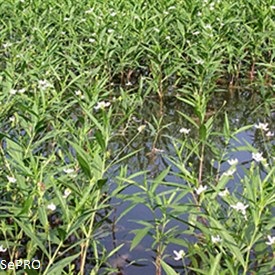
Ecological Importance
Deer will browse the leaves of American Water Willow, while beaver, muskrat, and nutria will consume the rhizomes. American Water Willow provides shoreline stabilization around lakes and ponds.
Problems
American Water Willow may form dense colonies making recreational activities difficult.
American Water-willow leaves are shiny green on top, pale on the bottom, arranged opposite and have a long, narrow tapered appearance very similar to the leaves of willow trees. The tree bark is dark brown or black with ridges.
Plant Description:
American Water-willow is found in places with an abundant water and sunlight supply and is seen as both a shrub and a large tree along streams, ponds and lake margins. It often has multiple trunks, each with many branches coming from each.
The stems do not usually branch and have prominent whitish lines. Water-willow flowers from May through October. The flowers are on long stems originating from the base of the leaves. Flowers are 5-petaled orchid-like (3/4 inch diameter), white with purple/violet streaks on the lower petals. Water-willow can spread from seeds and forms extensive rhizomes by which it forms colonies and spreads rapidly.
Hints to Identify
Look for long, narrow, tapered leaves much like a willow tree has. Leaves may have toothed edges.
|
Homeowner Treatment Options
|
| Sonar AS |
| Sonar RTU |
| *Aquatic Biologists recommends implementing preventative management techniques and physical removal prior to, or in conjunction with treatment. |
Common Application Questions
Q. How much should I treat?
A. Spot treat as needed to maintain access from recreational activities. Remember this plant is very beneficial and should not be treated where it is not a nuisance.
Q. When is the best time to treat?
A. Once water temperatures are around sixty degrees or warmer.
Q. How often do I need to treat American Water Willow?
A. One to two treatments may be needed throughout the growing season.
Q. How long before I see results?
A. It really depends on the product you choose. For most vegetation, control will take approximately 2 weeks however, tissue damage may be evident within 2 to 4 days with liquid formulations. Some products are slower acting with results taking 30 days or more to achieve.
